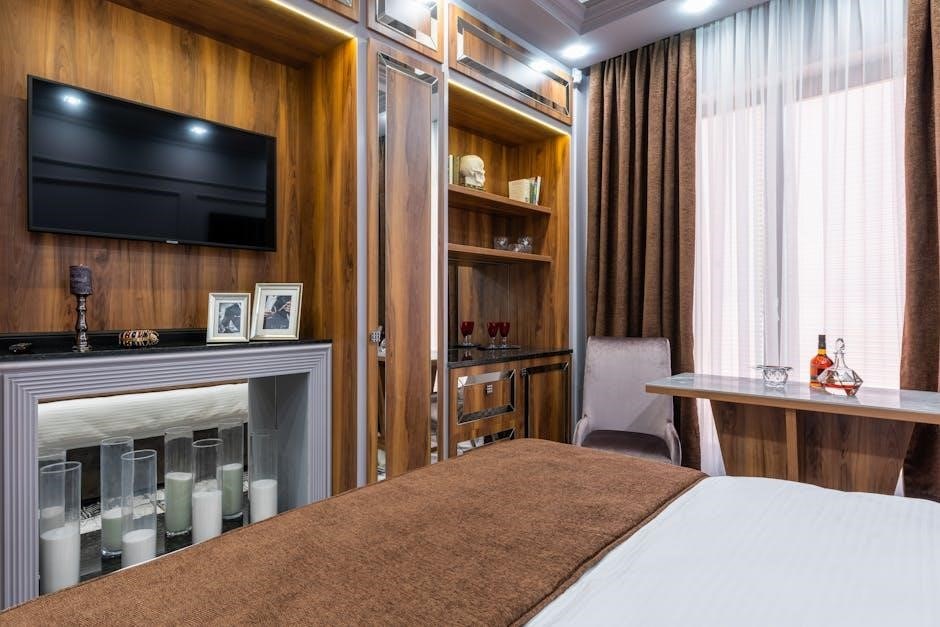Selecting the right picture frame size is crucial for showcasing your photos or artwork effectively. Understanding standard dimensions ensures a perfect fit, enhancing visual appeal and protecting your cherished memories or valuable art pieces.
Why Understanding Frame Sizes Matters
Understanding picture frame sizes is paramount for several reasons. Firstly, it ensures that your photographs or artwork fit perfectly within the frame, preventing unsightly gaps or overlaps. A well-fitted image enhances the overall aesthetic appeal and professionalism of the display. Secondly, knowing standard frame sizes simplifies the purchasing process. Instead of guessing or relying on inaccurate measurements, you can confidently select frames that match your specific needs, whether you’re buying online or in a retail store. This saves time and reduces the likelihood of returns or exchanges. Thirdly, understanding frame sizes is essential when considering matting. Matting not only adds a decorative border but also protects the artwork from direct contact with the glass. Calculating the correct frame size with matting requires precise measurements and knowledge of standard dimensions. Furthermore, familiarity with frame sizes allows you to explore various display options. Different sizes are suitable for different types of images and spaces. For instance, smaller frames are ideal for displaying snapshots on a desk or shelf, while larger frames are better suited for showcasing statement pieces on walls. By understanding the relationship between image size, frame size, and matting, you can create visually stunning displays that complement your home decor. In addition, understanding frame sizes can be beneficial when commissioning custom frames. Custom frames offer the flexibility to create unique designs and accommodate non-standard image sizes. However, knowing the basic principles of frame sizing ensures that you can communicate your requirements effectively to the framer and achieve the desired result; Ultimately, mastering picture frame sizes empowers you to make informed decisions, save time and money, and create beautiful displays that showcase your cherished memories and artistic creations in the best possible light. Whether you’re a seasoned art collector or simply looking to decorate your home with personal photos, a solid understanding of frame sizes is an invaluable asset.

Standard Picture Frame Dimensions
Picture frames come in a variety of standard sizes, catering to different photo and artwork dimensions. These sizes are typically expressed in inches or centimeters, providing a convenient way to find the perfect fit for your needs, whether you’re in Australia or elsewhere.
Common Imperial Sizes (Inches)
When it comes to picture frames, imperial sizes, measured in inches, are widely used, especially in the United States. Understanding these common dimensions is crucial for selecting the right frame to complement your photographs, artwork, or documents. Here’s a rundown of some of the most frequently encountered imperial frame sizes:
- 4×6 inches: This is one of the most popular sizes for standard photographs, often used for family snapshots, vacation photos, and everyday memories. A 4×6 frame is ideal for displaying these prints on a tabletop or arranging them in a gallery wall.
- 5×7 inches: Slightly larger than 4×6, the 5×7 size is another common choice for photographs, offering a bit more visual impact. It’s a great option for portraits, landscape shots, or images with more detail.
- 8×10 inches: This size is frequently used for portraits, certificates, and documents. An 8×10 frame provides ample space to showcase the subject matter, making it a popular choice for both personal and professional settings.
- 8×12 inches: Slightly less common than 8×10, the 8×12 size offers a different aspect ratio, which can be suitable for certain types of photographs or artwork. It provides a wider field of view compared to the 8×10 format.
- 10×12 inches: This size offers a more substantial display area, suitable for larger photographs, artwork, or documents. It’s a good option for showcasing pieces that deserve more prominence.
- 11×14 inches: A popular choice for displaying larger prints, posters, or artwork, the 11×14 size offers a significant visual presence. It’s often used for framing movie posters, art prints, or important documents.
- 12×16 inches: This size is ideal for showcasing artwork or photographs with a more panoramic view. It provides a wider aspect ratio, allowing for a more immersive viewing experience.
- 14×18 inches: Designed to display a 12×16 photo with a mat, ensuring a vibrant textured cream color.
- 16×20 inches: A common size for larger prints and artwork, the 16×20 frame commands attention and is often used for statement pieces. It’s a great option for showcasing artwork, posters, or large photographs.
- 18×24 inches: This is a substantial size, suitable for large posters, artwork, or photographs. An 18×24 frame makes a bold statement and is often used for focal points in a room.
These are just some of the common imperial frame sizes available. When selecting a frame, it’s essential to consider the dimensions of your artwork or photograph and choose a size that complements the piece while providing adequate support and protection.
Common Metric Sizes (Centimeters)
While imperial sizes (inches) are prevalent in some regions, metric sizes (centimeters) are widely used in many parts of the world. Understanding common metric frame dimensions is essential for those working with international artwork or photographs, or simply preferring the metric system. Here’s an overview of frequently encountered metric frame sizes:
- 10 x 15 cm (approximately 4×6 inches): This size is a common metric equivalent to the standard 4×6 inch photograph. It’s suitable for small snapshots, family photos, and everyday prints.
- 13 x 18 cm (approximately 5×7 inches): Similar to the 5×7 inch size, this metric dimension is often used for portraits, landscape photos, or images with slightly more detail.
- 15 x 20 cm (approximately 6×8 inches): This size is a close metric equivalent to 6×8 inches, offering a slightly larger display area than the 4×6.
- 20 x 25 cm (approximately 8×10 inches): This metric size corresponds closely to the popular 8×10 inch frame, making it suitable for portraits, certificates, and documents.
- 20 x 30 cm (approximately 8×12 inches): This metric size corresponds closely to the popular 8×12 inch frame, making it suitable for portraits, certificates, and documents.
- 25 x 30 cm (approximately 10×12 inches): Providing a more substantial display area, this size is suitable for larger photographs, artwork, or documents that deserve more prominence.
- 28 x 35 cm (approximately 11×14 inches): A popular choice for displaying larger prints, posters, or artwork, this metric size offers a significant visual presence, similar to the 11×14 inch frame.
- 30 x 40 cm (approximately 12×16 inches): Ideal for showcasing artwork or photographs with a wider aspect ratio, this metric size provides a more immersive viewing experience, comparable to the 12×16 inch frame.
- 40 x 50 cm (approximately 16×20 inches): This metric size is a common choice for larger prints and artwork, commanding attention and often used for statement pieces, similar to the 16×20 inch frame.
When choosing a metric frame size, consider the dimensions of your artwork or photograph and select a size that complements the piece while providing adequate support and protection. Remember to account for any matting or borders when determining the appropriate frame size.

Popular Photo Sizes and Corresponding Frames
Certain photo sizes are more commonly printed than others, leading to readily available frame options. Understanding these popular sizes and their ideal frame pairings simplifies the selection process and ensures a perfect presentation for your cherished memories.
4×6, 5×7, and 8×10 Frames
These three sizes represent the most popular choices for both photo prints and picture frames. Their prevalence stems from their versatility and suitability for a wide range of images and display purposes. Let’s delve into why these sizes are so commonly used and explore the best ways to utilize them.
4×6 Frames: Often the go-to size for everyday snapshots, 4×6 prints are perfect for displaying casual photos from vacations, family gatherings, and other memorable moments. Frames for 4×6 photos are widely available and relatively inexpensive, making them an excellent choice for creating collages or filling photo albums. They are ideal for smaller spaces, such as desks, shelves, or bedside tables. The compact size allows for easy arrangement and rearrangement, giving you the flexibility to update your displays as new photos are taken.
5×7 Frames: Slightly larger than 4×6, 5×7 photos and frames offer a more prominent display without overwhelming a space. This size is well-suited for portraits, landscapes, and more artistic compositions. The increased dimensions allow for greater detail and visual impact. 5×7 frames are commonly used for showcasing professional photos, such as school portraits or family portraits taken by a photographer. They also work well for displaying travel photos or images with significant sentimental value. The added size makes them suitable for hanging on walls or displaying on mantels.
8×10 Frames: Considered a standard size for formal portraits and artwork, 8×10 frames provide a substantial presence and are often used for creating a focal point in a room. This size is ideal for showcasing high-quality prints, professional photographs, and significant achievements. 8×10 frames are commonly used for displaying graduation photos, wedding photos, and professional headshots. They are also a popular choice for framing certificates, awards, and other important documents. The larger size makes them suitable for displaying on walls, above furniture, or in prominent locations where they can be easily admired.
When choosing between these sizes, consider the size of the image, the purpose of the display, and the overall aesthetic of the space. Whether you’re creating a casual collage or showcasing a cherished portrait, these popular frame sizes offer a versatile and readily available solution for all your framing needs.

Choosing a Frame with a Mat
Selecting a frame with a mat enhances your artwork or photos by adding visual space and drawing attention to the image. The mat board acts as a border, preventing the image from directly touching the glass and providing an extra layer of preservation.
Calculating Frame Size with Matting
To determine the ideal frame size when using a mat, you need to consider the dimensions of your artwork or photo and the desired width of the mat border. Here’s a step-by-step guide:
- Measure Your Artwork: Accurately measure the height and width of the image you intend to frame. This is crucial for precise calculations.
- Decide on Mat Width: Determine how wide you want the mat border to be. A common width is 2 inches, but you can adjust this based on the size of the artwork and your personal preference. For smaller images, a narrower mat (e.g., 1.5 inches) may be more suitable, while larger pieces can handle a wider mat (e.g., 3 inches or more).
- Calculate Mat Dimensions: Multiply the desired mat width by 2 (since the mat borders the image on all sides). Add this value to both the height and width of your artwork.
- Example: If your artwork is 8×10 inches and you want a 2-inch mat border:
- Mat width addition: 2 inches x 2 = 4 inches
- New height: 10 inches + 4 inches = 14 inches
- New width: 8 inches + 4 inches = 12 inches
- Example: If your artwork is 8×10 inches and you want a 2-inch mat border:
- Determine Frame Size: The final frame size should match the outer dimensions of the mat. In the example above, you would need a 12×14 inch frame.
- Consider Mat Overlap: Ensure that the mat slightly overlaps the edges of your artwork to hold it securely in place. A common overlap is 1/4 inch on each side. This means the visible area of the mat will be slightly smaller than the calculated dimensions. Account for this when cutting the mat board.
- Account for Frame Rabbet: The rabbet is the recessed area on the inside of the frame that holds the glazing, mat, and artwork. Make sure the rabbet depth is sufficient to accommodate all these layers.
- Test with Mockups: Before making any final decisions, it can be helpful to create a mockup using cardboard or paper to visualize how the artwork will look with the mat and frame. This allows you to adjust the mat width and frame size as needed.
By following these steps, you can accurately calculate the frame size needed when using a mat, ensuring a professional and aesthetically pleasing presentation of your artwork or photos.

Uncommon and Large Frame Sizes
While standard frame sizes cater to the most frequently printed photo and art dimensions, there are instances where you’ll need to explore uncommon or large frame sizes. These are often required for panoramic prints, oversized posters, gallery-style displays, or unique art pieces that deviate from conventional dimensions. Navigating these less common sizes requires a bit more planning and awareness of your options.
Understanding Uncommon Sizes:
- Panoramic Frames: Panoramic photos, with their elongated shape, necessitate specialized frames. Common panoramic sizes include 12×36 inches, 16×48 inches, and even larger. These frames are designed to accommodate the wider aspect ratio without cropping the image.
- Square Frames: Square formats are becoming increasingly popular, especially with the rise of social media photography. Common square frame sizes include 12×12 inches, 16×16 inches, and 20×20 inches.
- Odd-Sized Art: Original artwork or prints may come in unique sizes that don’t conform to standard dimensions. In these cases, custom framing is often the best solution.
Navigating Large Frame Sizes:
- Structural Considerations: Large frames require robust construction to prevent warping or sagging. Look for frames made from sturdy materials like hardwood or metal. Acrylic glazing is often preferred over glass for large frames due to its lighter weight and shatter-resistant properties.
- Weight and Hanging: The weight of a large framed piece can be significant, so it’s crucial to use appropriate hanging hardware and ensure that your wall can support the load. Consider using heavy-duty picture hooks or seeking professional installation.
- Custom Framing: For very large or unusually shaped items, custom framing is often the only viable option. Custom framers can create frames to your exact specifications, ensuring a perfect fit and optimal presentation. They can also advise on the best materials and construction techniques for your specific needs.
- Cost: Be prepared for higher costs when dealing with uncommon or large frame sizes. The increased material requirements and specialized labor involved in custom framing can significantly impact the price.
Where to Find Uncommon and Large Frames:
- Online Retailers: Many online retailers offer a wider selection of frame sizes than brick-and-mortar stores. Look for websites that specialize in art supplies or custom framing.
- Custom Framing Shops: Local custom framing shops can create frames to your exact specifications. This is often the best option for unusually sized or shaped items.
- Art Supply Stores: Some art supply stores carry a range of frame sizes, including larger and less common dimensions.
When dealing with uncommon or large frame sizes, careful planning and attention to detail are essential to ensure a successful and visually appealing result. Don’t hesitate to seek professional advice from framers or art consultants if you’re unsure about the best approach.
Where to Buy Standard Size Frames
Finding standard size picture frames is generally a straightforward process, thanks to their widespread availability. Numerous retailers, both online and in physical stores, offer a diverse selection of frames in common dimensions, catering to various styles and budgets. Knowing where to look can save you time and ensure you find the perfect frame to complement your photo or artwork.
Online Retailers:
- Amazon: A vast online marketplace with a seemingly endless selection of picture frames from various brands and sellers. You can easily filter by size, material, style, and price to narrow down your options. Read customer reviews to gauge the quality and accuracy of the product descriptions.
- Etsy: A great place to find unique, handcrafted, or vintage picture frames; Many independent sellers offer standard sizes in a variety of materials and styles, often with a focus on artisanal craftsmanship.
- Specialty Frame Retailers: Several online retailers specialize in picture frames and related supplies. These stores often offer a wider selection of sizes, materials, and styles than general retailers, and may also provide custom framing services.
- Big Box Stores (Online): Major retailers like Walmart, Target, and Costco also offer a selection of standard size picture frames on their websites. These are often competitively priced and may be eligible for free shipping or in-store pickup.
Physical Stores:
- Craft Stores: Stores like Michaels, Hobby Lobby, and Jo-Ann Fabrics carry a wide range of picture frames in standard sizes, as well as matting, hardware, and other framing supplies. They often have sales and coupons available, making them a budget-friendly option.
- Home Goods Stores: Stores like HomeGoods, TJ Maxx, and Marshalls often have a rotating selection of picture frames at discounted prices. However, the availability of specific sizes and styles may vary.
- Department Stores: Department stores like Macy’s, Kohl’s, and JCPenney typically have a home decor section that includes picture frames. The selection may be more limited than at specialty stores, but you can often find good deals during sales events.
- Furniture Stores: Some furniture stores, particularly those that specialize in home decor, also carry a selection of picture frames. These may be higher-end frames with more elaborate designs.
- Discount Stores: Stores like Dollar General and Dollar Tree may carry very basic picture frames in standard sizes at extremely low prices. These are a good option for budget-conscious shoppers who don’t need a high-quality frame.
Tips for Buying Frames:
- Measure Carefully: Double-check the dimensions of your photo or artwork before purchasing a frame.
- Consider the Mat: If you plan to use a mat, factor in its width when choosing the frame size.
- Read Reviews: Before buying online, read customer reviews to get an idea of the frame’s quality and appearance.
- Check Return Policies: Make sure the retailer has a good return policy in case the frame doesn’t meet your expectations.
- Compare Prices: Shop around to compare prices and find the best deal.
With a little research, you can easily find standard size picture frames at a variety of retailers to suit your needs and budget.
